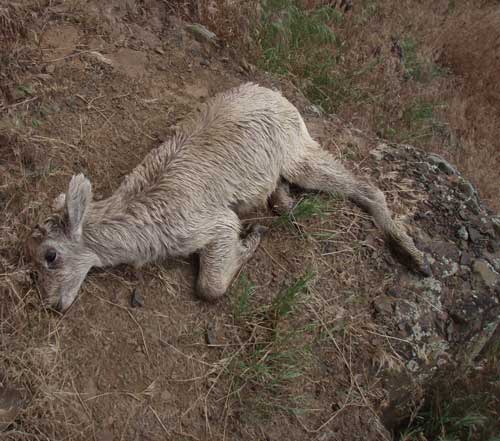About Pneumonia
Where did bighorn pneumonia come from?
Pneumonia is one of the biggest hurdles limiting the comeback of bighorn sheep in western North America. People have known about the disease since the 1990's, but progress in identifying the causative agent has been slow. Domestic sheep and goats brought in to graze in bighorn sheep habitat introduce pneumonia to wild sheep. Attempts to manage the disease in bighorn sheep are costly and frustrating and have met with limited success.
Why do some bighorn herds recover from pneumonia while others do not?
When a bighorn sheep population is initially infected, often as many as a third, and sometimes up to 90%, of the herd may die of pneumonia. Most survivors are apparently immune, but their lambs are not and usually die before weaning. In some populations, annual pneumonia outbreaks in lambs continue for decades after the initial infection, which prevents the population from bouncing back. In other populations, lamb survival returns to normal relatively quickly. Why some populations recover and others do not is one of the most important questions we are trying to answer.
What's a bighorn sheep with pneumonia sound like? Watch this excerpt from a longer feature by Oregon Public Broadcasting to hear the cough.
Recent Breakthroughs in Finding a Pathogen
Researchers have struggled to identify the pathogen responsible for pneumonia in bighorn sheep. Many different bacteria, and sometimes viruses, can be found in bighorn sheep with pneumonia. Many of these same bacteria and viruses are also found in healthy sheep.
However, with improvements in DNA technology, microbiologists were able to detect a pathogen, called Mycoplasma ovipneumoniae, that is always found in sheep with pneumonia and rarely found in healthy sheep. Mycoplasma ovipneumoniae predisposes bighorn sheep to infection by a multitude of other pathogens, resulting in a "poly-microbial" pneumonia. Read more about Mycoplasma ovipneumoniae in bighorn sheep.
Pneumonia Outbreaks
This animation shows the spread of pneumonia through the metapopulation since 1995. By 2012 all of the populations had been affected. However, once infected, their long term dynamics were extremely variable. Some populations declined, some stayed stable. Many populations have years of good lamb survival that are interspersed with years of poor lamb survival. We are currently investigating whether the populations are still infected during the years when lambs survive—we suspect that pathogen is still present in most cases, but it is also possible that the pathogen is fading out and being reintroduced.
Mortalities
Bighorn sheep around the west regularly experience pneumonia outbreaks. State agencies decide whether to intervene or not in trying to control an outbreak of pneumonia, depending on whether the herd can easily be reached, how many sheep are sick or dying, and other factors. You can read about some of the larger outbreaks that happened in in 2012 and 2011 in the west, though there were many more outbreaks than are listed here.
Around the West
The Wildlife Management Institute's website reports on various outbreaks around the west, and different strategies to control them.
Washington
Washington State's bighorns suffered a large outbreak of pneumonia in 2010, in the Yakima River canyon. The state euthanized about one third of the Yakima River bighorns in an attempt to stop the spread of pneumonia.
Another large outbreak occurred two years later, in April 2013. This outbreak severely reduced the Tieton herd near Naches.
Montana & Yellowstone
In the past several years Montana has lost hundreds of bighorns to pneumonia. Watch this video about bighorn pneumonia in Montana from the Montana Fish, Wildlife, and Parks.
In January 2012, bighorn pneumonia was reported in Yellowstone National Park.
Oregon
Oregon Public Broadcasting aired this video, featuring Frances Cassirer, about bighorn pneumonia in Hells Canyon.



